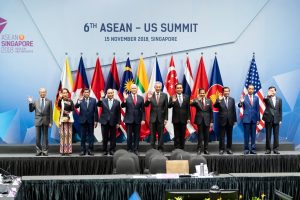Last week, the United States and countries in the Association of Southeast Asian Nations (ASEAN) held a high-level conference on the global coronavirus pandemic. Though this was just one of several interactions between the two sides in this regard, it nonetheless spotlighted one area on which Washington and Southeast Asian states have been looking to advance collaboration amid a crisis and the opportunities and challenges in this respect.
While U.S.-ASEAN relations have continued to functionally advance over the past few years under the mechanism of a strategic partnership institutionalized during the presidency of Barack Obama, multilateral engagement has encountered some challenges under U.S. President Donald Trump, despite occasional advances made bilaterally. The coronavirus pandemic has served as a test for how Washington and Southeast Asian states can cooperate amid a crisis.
The consequences of COVID-19 for U.S.-ASEAN relations was clear early on, with the virus being the stated rationale for the eventual cancellation of a proposed U.S.-ASEAN Special Summit in Las Vegas back in February. Since then, the United States has become a key epicenter in the pandemic, while the virus has become truly regional in Southeast Asia after weeks of speculation that had preceded about an understatement of the COVID-19 challenge in the region.
But amid this evolution, there has been a greater focus on ASEAN’s relationships with major powers, be it ASEAN+3 countries China, Japan, and South Korea or the United States. While that focus has usually been on headline-making assistance or funding amounts, U.S. assistance with coronavirus has focused on longstanding areas of emphasis that are still continuing amid COVID-19, including assistance to individual countries and ASEAN covering preparedness, diagnostic capabilities, and exchange programs; the provision of expertise, training, and human capital via a range of agencies such as the U.S. Centers for Disease Control and Prevention (CDC) and the U.S. Agency for International Development (USAID); and prior support for regional organizations such as the UN Refugee Agency (UNHCR) and the World Health Organization which have also been involved in managing aspects of the pandemic.
Last week, we saw a focus on this aspect of U.S.-ASEAN relations with the holding of a high-level videoconference. A videoconference was held on April 1 between U.S. officials from several agencies and ASEAN officials from the ASEAN Coordinating Council Working Group on Public Health Emergencies to discuss U.S.-ASEAN cooperation in countering the COVID-19 pandemic as well as collaboration in public health emergencies more generally.
Per a co-chairs statement issued following the meeting, both sides discussed a range of issues regarding COVID-19 that they had confronted, including emergency measures and repatriation of citizens. They also discussed potential for future engagement tied to COVID-19, be it on functional areas including infection control, training for health personnel, producing medical supplies and vaccines, and managing economic fallout on trade; new mechanisms, including a new special fund for public health emergencies to address outbreaks including COVID-19 or an East Asia Summit (EAS) forum on strengthening pandemic preparedness; and future engagements such as videoconferences between foreign affairs and health officials and experts.
The proposals for future engagement are not without significance for the relationship and for the United States and ASEAN individually. Though they build on existing lines of effort and some of them had been in the works before as well, they would help open more channels for cooperation for both sides if followed through on and showcase both Washington’s commitment to supporting ASEAN and ASEAN’s continued relevance in Asia’s regional architecture which has come under scrutiny previously.
To be sure, advancing these areas of cooperation are not without their challenges. On the U.S. side, despite the breadth of potential U.S. interagency engagement on COVID-19 and the clear willingness to advance aspects of collaboration at the bureaucratic level, it can take a while to coordinate and actually disburse assistance to individual ASEAN countries and to ASEAN as a grouping under the broad umbrella objectives of U.S. policy as Washington also deals with its own coronavirus challenge at home. And on the ASEAN side, despite having a capable and active chair in Vietnam for 2020, the organization will have to juggle advancing U.S.-ASEAN cooperation with a whole host of other priorities, including establishing new mechanisms and promoting ties with other external partners.
There are also concerns and uncertainties on both sides about the management of COVID-19 as well that continue to be expressed privately rather than in official statements. These include U.S. anxieties about aspects of democracy and rights in some Southeast Asian countries, and Southeast Asian reservations about aspects of the Trump administration’s response and its effects on how the world is confronting the global pandemic amid continued U.S.-China tensions and during an election year in the United States.
Naturally, the official accounts of the U.S.-ASEAN high-level conference on COVID-19 placed a greater and more direct emphasis on opportunities rather than the aforementioned challenges and uncertainties. But the ability of both sides to actually break ground on their stated areas of cooperation will ultimately depend on their ability to manage both opportunities and challenges with respect to COVID-19 and the wider relationship. As such, how they do so will continue to be important to watch in the coming weeks and months.
































